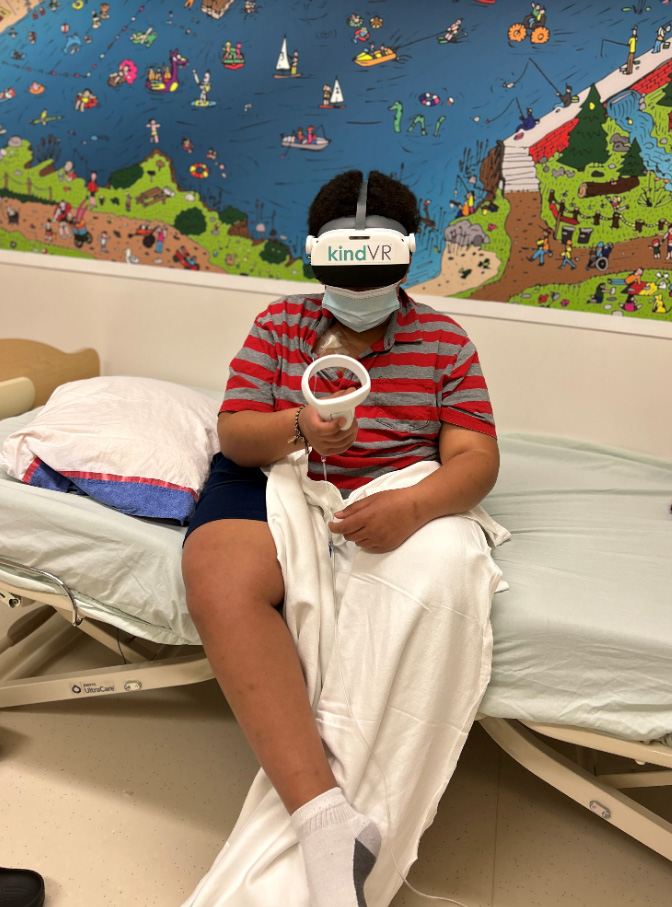 When pediatric patients require infusion therapy, the experience can often make them feel anxious or nervous. Infusions require placing an IV in the child’s arm or using a needle to access a port within the chest, procedures that can be uncomfortable and scary for kids.
When pediatric patients require infusion therapy, the experience can often make them feel anxious or nervous. Infusions require placing an IV in the child’s arm or using a needle to access a port within the chest, procedures that can be uncomfortable and scary for kids.
Dr. Aaron Weiss, Nurse Amanda McGeachey and their colleagues at the new Sam L. Cohen Pediatric Infusion Center at Maine Children’s Cancer Program (MCCP) wanted to alleviate the stress for these kids and thought virtual reality might be the answer. They brought the idea to MaineHealth Innovation and took part in the 2022 Spring Cohort to develop the concept. With the support and guidance of the Cohort, they’ve created a program to provide patient’s virtual and augmented reality experiences to distract them and create a calming environment during their procedures.
When patients come to the clinic, they’re outfitted with a VR headset that has six programs to choose from, such as feeding animals on safari or swimming with fish. The VR programs are designed to have the kids hold their head up, which is the best position for a nurse to access their port. The kids control the games, and the headsets can be tailored to each patient’s needs. So far, a number of patients have tried the headsets during procedures and the reviews by both patients and their caregivers have been great. The headsets are primarily visual, but audio is also available with sound embedded in the head strap. An MCCP nurse, child life specialist or social worker help with the VR setup, so other staff and parents can focus on other important tasks.
The annual fees to KindVR, the company that created the hardware and software, are generously provided by the Sam L. Cohen Foundation. The company was selected after careful evaluation of available distraction technology by MCCP staff in collaboration with members of the MaineHealth Innovation Cohort.
Aaron, Amanda and their team set out to create a special and unique experience for their pediatric patients, and the VR headsets do just that. Other hospitals have adopted similar technology.
“I think the biggest positive so far about the VR headset is that it’s almost like a video game and it seems like it’s something they’re familiar with. When they have the headset on, they really aren’t thinking about what’s going on around them (i.e. port access, lab draws), and they’re easily distracted with telling me what underwater animals they can interact with or which desert animals they help find water. When some kids come into clinic, they’ll immediately say, ’I need the VR for my access,’ which has been really helpful to us. It’s been awesome to be able to follow along with what they see just by having the paper that tells you the times/animals/what’s happening next.”
– Megan Walls, CNA, MCCP Certified Nursing Assistant
Next Steps
The MCCP care team is surveying patients and families about their experience with VR, so they can refine the process to make every pediatric patient’s infusion procedure as anxiety-free as possible. Moving forward, more staff will be trained to assist patients with VR, and there’s potential to expand VR access to other locations, such as the emergency room, radiology and radiation therapy, where the ability to remain still during a procedure can be critical for patient care.
Collaborators
- Aaron Weiss, DO
- Beth Eilers, LCSW, MCCP Social Work
- Amanda McGeachey, BSN, APHON, MCCP Clinical Manager
- Jay Westra, RN, CPHON, MCCP School Liaison Nurse
- Nadav Kastle, MD, MCCP Physician
- Jaime McCaffrey, CCLS, MCCP Child Life Specialist
- Megan Walls, CNA, MCCP Certified Nursing Assistant
- Debra Matson, MCCP Director of Practice Operations
- Child Life Services
Our Purpose
MaineHealth Innovation builds connections to drive diversity of thought, educates to produce creative problem-solvers and funds to accelerate ideas. By leveraging the ideas, insights and expertise of all care team members to develop novel solutions to our unmet care needs, we are working together so our communities are the healthiest in America.
